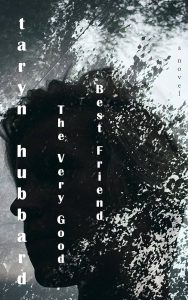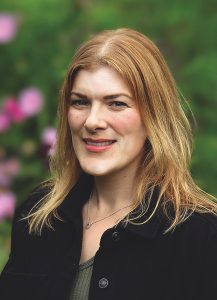A good new reason to skip the mall
The Very Good Best Friend
by Taryn Hubbard
Surrey: Now Or Never Publishing, 2025
$26.95 / 9781989689820
Reviewed by Logan Macnair
*

If, after a history of painful loss and social/professional failures, the only significant and positive relationship that you have been able to maintain were taken from you, what would you be willing to do to get it back?
Taryn Hubbard’s debut novel, a mystery/thriller ostensibly about cults, technomancy, self-aggrandizing billionaires, derelict shopping malls, and the double-edged sword of artificial intelligence, embeds that question within its pages, even though it’s a fundamentally human story about friendship, regret, and longing for that and those which have been lost.
The story begins with a prologue of sorts in the form of several letters sent from Rebecca to her best friend Carolyn. Rebecca is a gifted computer coder who several months prior made the bold decision—under the promise that a mysterious benefactor would pay her outstanding student loan debts—to upend her life in Vancouver to join and lend her talents to an experimental commune located in an abandoned mall somewhere in the Kootenays.
Upon reading the wording of these letters some immediate red flags become apparent to Carolyn, who surmises that what her friend has become involved with is less a utopian commune funded by a benevolent billionaire than an exploitative cult that she has become unwittingly trapped within. And thus, our hero Carolyn embarks on a journey to rescue her friend from these conditions.
I use the word ‘hero’ loosely here, as at a cursory glance Carolyn does not embody or express any of the traditionally heroic qualities or skills commonly seen in the genre. On the contrary, she is, to put it bluntly, a bit of a dud—an assessment that she herself would likely agree with.
In her early thirties Carolyn works at a low-paying temp job in a legal office. Along with financial struggles she has high levels of social anxiety, a strained relationships with her family, and a floundering love life. “I’m useless at this kind of stuff,” she says at one point, referring to her inability to fix her stalled car; “and at life in general,” she further muses. This seems an apt summary of her levels of self-confidence and assuredness.

It becomes clear that her friendship with Rebecca has been one of the only positive and fulfilling relationships that Carolyn has been able to maintain, which does help to explain her motivations for wanting to ‘rescue’ her from the commune—even if one gets the sense that Carolyn needs Rebecca more than the other way around.
While there certainly are moments of relatability to Carolyn’s self-critical inner monologue (aided by Hubbard’s ability to authentically replicate these vulnerable lines of thinking) and her strong desire to salvage what might be the last healthy social relationship she has, her self-defeatism occasionally stifles her in ways that almost prohibit her own agency in the story. That makes her difficult to empathize with as protagonist as a result.
There are moments when Carolyn seems to be dragged almost unwillingly into the plot by external forces or characters; and her standard reaction to much of the conflict she finds herself in, whether minor or major, is to give in to internal dread and freeze up. “When I panic, my body turns to stone,” she confides, not unlike the reaction of a fainting goat.
With that said, it may well be this inner doubt and fear that allows her to exhibit bravery in her own way. Bravery is not solely the currency of conventional heroes fearlessly rushing in headfirst to confront evil; sometimes bravery simply means challenging and going beyond your own personal limitations and confines. In this sense, in her unrelenting pursuit of rescuing her best friend, Carolyn certainly is brave.
And it is this rescue attempt that undergirds all three acts of this tightly-paced novel. In the first, Hubbard provides exposition and background as Carolyn prepares (both emotionally and practically) to embark. She gives insights into Carolyn’s tragic family history and make us understand why Rebecca has become so important to her. And as with any good mystery, breadcrumbs and clues that will become significant much later are laid out early on here—some of which I had missed entirely and was pleasantly surprised by when they were later reintroduced.
In the second act, Carolyn begins her eastward road trip for the commune where she meets several characters along the way, all of whom serendipitously appear to have some connection to the abandoned mall and the project being undertaken therein. Some more overtly ‘supernatural’ (for lack of a better term) elements are introduced here, indicating that whatever is happening in that mall is starting to bleed out into the outside world in ways that effectively intrigued me and kept me reading for answers.
As the true nature of the work at the commune becomes apparent in the third act, the novel, largely grounded hitherto, starts to more closely resemble an episode of Black Mirror. Here, where we meet Matt, the billionaire behind the operation, who in effect serves as the novel’s primary antagonist.
The twists and revelations come on strong and fast in these last few chapters, and the rush toward the end might have benefited from a bit more time to set up and process, but Fraser Valley resident Hubbard (Desire Path) effectively ties everything together well here—including meaningful and satisfying payoffs for several setups established much earlier in the novel.
This is also where some of the novel’s sub-themes and social commentaries are explored in greater detail. Specifically, the oxymoron of ‘benevolent billionaires,’ those with means who pose as socially enlightened friends and benefactors of humanity and positive progress, but in reality hunger only for deeper—cultural, financial, technological—control of society, whether.
The theme of technology is also explored through the question of how emergent technologies (artificial intelligence in particular) can or should be used and whether the ethical application/use of such material will inherently conflict with corporate or financial interests. To this end, this story serves as a strong reminder to actually read terms and conditions policies before casually checking the box.
Interesting as they are, these ideas are ultimately tangential to the main concerns of the book: how we cope with loss and tragedy, how we negotiate feelings of regret, and how these burdens can weigh upon us in ways that shape our trajectories. Hubbard’s characters approach them with an effective level of rawness and emotional vulnerability.
[Editor’s note: Taryn Hubbard will read (with Loghan Paylor and Harper Carr) at Words in the Burbs, Thursday April 24, 7-9pm, Western Sky Books, Port Coquitlam. The author’s website lists further readings in May and June.]

*

Logan Macnair is a novelist and college instructor based in Burnaby. His academic research is primarily focused on the online narrative, recruitment, and propaganda campaigns of various political extremist movements. His second novel Troll (Now Or Never Publishing, 2023) is a fictionalized account based on his many years of studying online extremist groups. [Editor’s note: Jessica Poon reviewed Logan’s Troll in BRC. He’s reviewed Tamas Dobozy, Andrew Battershill, Kate Black, Kawika Guillermo, and James Hoggan with Grania Litwin for BCR.]
*
The British Columbia Review
Interim Editors, 2023-26: Trevor Marc Hughes (non-fiction), Brett Josef Grubisic (fiction and poetry)
Publisher: Richard Mackie
Formerly The Ormsby Review, The British Columbia Review is an online book review and journal service for BC writers and readers. The Advisory Board now consists of Jean Barman, Wade Davis, Robin Fisher, Barry Gough, Hugh Johnston, Kathy Mezei, Patricia Roy, and Graeme Wynn. Provincial Government Patron (since September 2018): Creative BC. Honorary Patron: Yosef Wosk. Scholarly Patron: SFU Graduate Liberal Studies. The British Columbia Review was founded in 2016 by Richard Mackie and Alan Twigg.
“Only connect.” – E.M. Forster